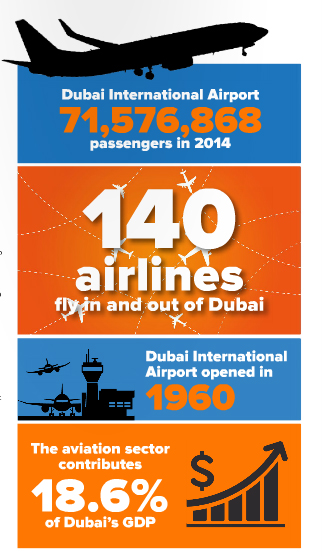With a growing number of passengers and an ever-expanding fleet of planes, flydubai is soaring. With success such as theirs, however, often come a few challenges. To address their IT needs, flydubai turned to virtualisation so that their vision would never be grounded.
Since its launch in 2008 the UAE-based airline flydubai has truly taken off. Established by the Government of Dubai, passengers boarded the airline’s first flight from its hub in Dubai to Beirut in 2009. In its sixth year of operation, the airline now serves more than 90 destinations across Africa, Caucasus, Central Asia, Europe, the Middle East and the Indian Subcontinent. In 2014 alone, 23 routes were added. flydubai has has undoubtedly contributed to Dubai’s rise as a regional and global travel destination.
It is not only flydubai’s route map that has expanded. In the last two years, the number of passengers served by the airline has increased as well. In 2014, flydubai reported 7.25 million passengers, up from 5.10 million in 2012. The count of the company’s fleet has grown to meet demand, as have the types of services – including Business Class which was launched in 2013.
With further expansion on the horizon, the brand is clearly on the rise. However, with organisational development come growing pains, and technology is no exemption. The IT department are tasked with insuring that all systems are “go”. Jayesh Maganlal, Manager, IT Enterprise Architecture, flydubai, manages the company’s technology initiatives with the goal of keeping customer experience high, while managing overall costs.
“Like any other organisation,” says Maganlal, “we are having healthy, organic growth.” That expansion, he says, needs support from the IT department. The larger the company becomes, the higher the demands on compute power and storage. “We have more than 3000 employees,” says Maganlal, “and closing in on 300 servers to manage.” In the past, when more resources were needed from the IT department to provide backing for new employees and projects, it has meant costly new hardware and infrastructure. Those days, explain Maganlal, are all but a thing of the past since flydubai has adopted cutting-edge solutions to address these growing pains. “We needed fast and secure backups and speedy restoration,” says Maganlal. “Our business needs were driving
us to consider new solutions for these issues.
“When it came to finding an updated solution, we needed a vendor with the ability to implement the product quickly and confidently,” says Maganlal. After the RFP process, Veeam was selected. In mid-2013, flydubai and Veeam began the proof of concept period for Veeam’s Availability Suite of products. “Veeam allowed us to have a thorough POC,” says Maganlal. “It lasted almost six months, and we had great support from the vendor during that time. They understood the unique aviation IT environment, and extended their support to us.”
In early 2014, flydubai took the solution to production. “We took on an implementation partner, and also extended professional services for the roll-out,” says Maganlal. Migration from the POC phase was seamless – almost. “There were a few issues during the implementation, as there is with any upgrade,” admits Maganlal. “In these few cases, however, the vendor understood that aviation is a 24/7 business, and was there for troubleshooting any time we needed.”
The difference was both obvious and instantaneous. “The entire upgrade took only a matter of days,” says Maganlal. He could see the solution working – the backups running instantly, with completion in ten to 15 minutes as opposed to two to three hours.
Now flydubai implements staggered backup throughout the day. Veeam uses Changed Block Tracking, a feature that helps perform incremental backups. Virtual disk block changes are tracked from outside virtual machines in the virtualisation layer. When software performs a backup, it can request transmission of only the blocks that changed since the last backup, or the blocks in use. This reduces backup time, as well as the amount of storage space needed.
The solution has also reduced overall downtime for flydubai. “In the past, if a machine was down, it could take hours to rebuild,” says Maganlal. “Now with Veeam in place, it is just about mounting those images on the HyperVisor and firing it up. It can be done within less than half an hour.”
Most importantly, the employee end-users have been pleased with the results of the upgrade. “It is an administrator’s worst nightmare,” explains Maganlal, “to wake up in the morning and see that a number of machines have failed in the overnight backup.” With the new solution, in the unlikely event that a backup does fail, there is an auto-restart mechanism that will attempt the backup repeatedly until it succeeds.
The benefits are not only seen in time saved, but also in the quality of the data collected. “Data integrity is as important,” says Maganlal. The solution from Veeam puts emphasis on data integrity with an automated verification of the health status of the backup. This means that not only are full backups done automatically for flydubai during their least busy hours at night, but the system verifies if the backup data is sound enough to restore the system and is not corrupted.
 For flydubai, the solution has provided unprecedented agility and flexibility – a game changer in the aviation industry. Now that IT can keep up with the business, the company is able to better take advantage of opportunities in the market. “A virtualised environment helps us to try new applications that might go to benefit the business or improve the customer experience as well,” says Maganlal.
For flydubai, the solution has provided unprecedented agility and flexibility – a game changer in the aviation industry. Now that IT can keep up with the business, the company is able to better take advantage of opportunities in the market. “A virtualised environment helps us to try new applications that might go to benefit the business or improve the customer experience as well,” says Maganlal.
“I think virtualisation has changed the whole world,” says Maganlal. “Not just our organisation, but how all companies function.” He points out that total cost of ownership is lower, allowing for a much more scalable infrastructure. The need for new hardware, he says, has been greatly reduced and new requests can be fulfilled in a fraction of the time.
As for the everyday passenger, he or she might not even notice the changes at flydubai – and that is the point. “Our customer experience should be like going to a nice restaurant – everything in the front of the house should be seamless, and the customer should never know what is going on in the kitchen.” That said, flydubai’s IT infrastructure is now mostly virtualised. “Aviation is 24/7, and simply cannot afford downtime,” says Maganlal.
As all critical applications of flydubai run on virtualised servers which now feature the Veeam Availability Suite, the solution ensures no potential loss of revenue, in addition to enabling constant availability of data and services and providing a much better user experience for staff and passengers alike.





